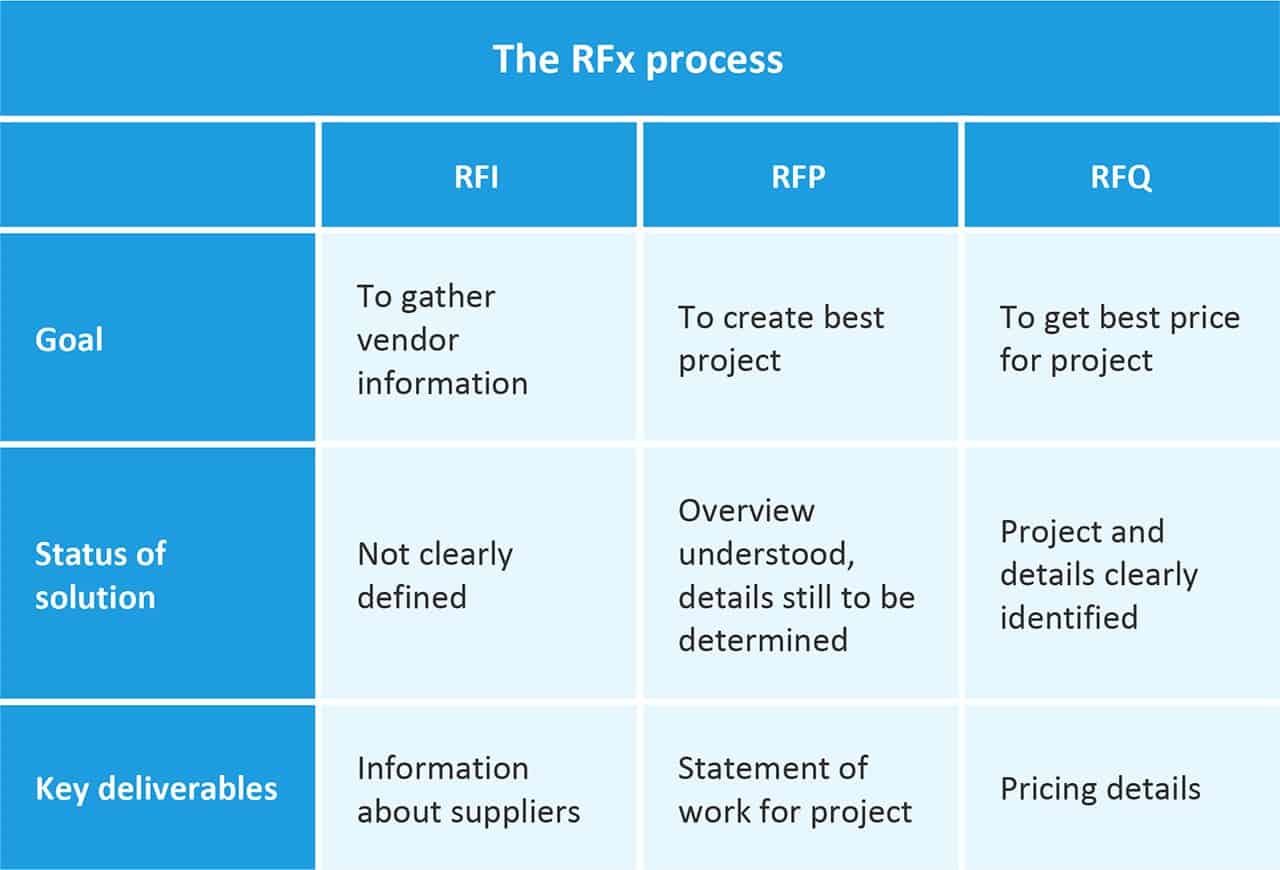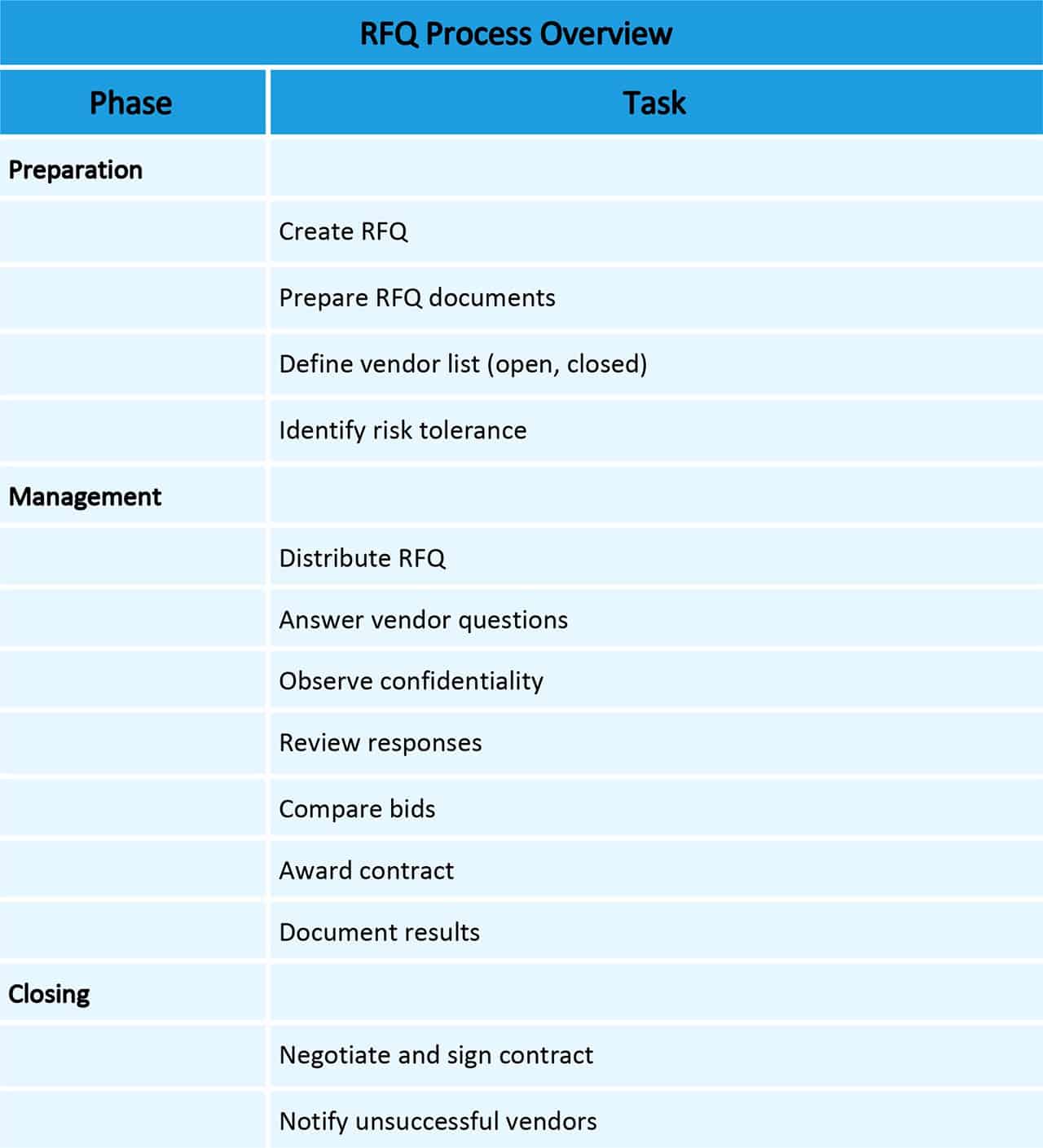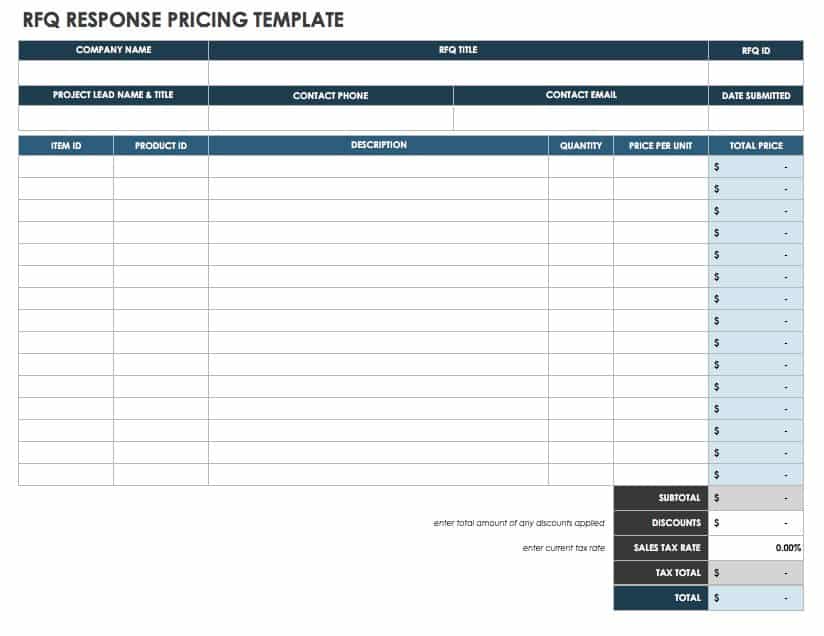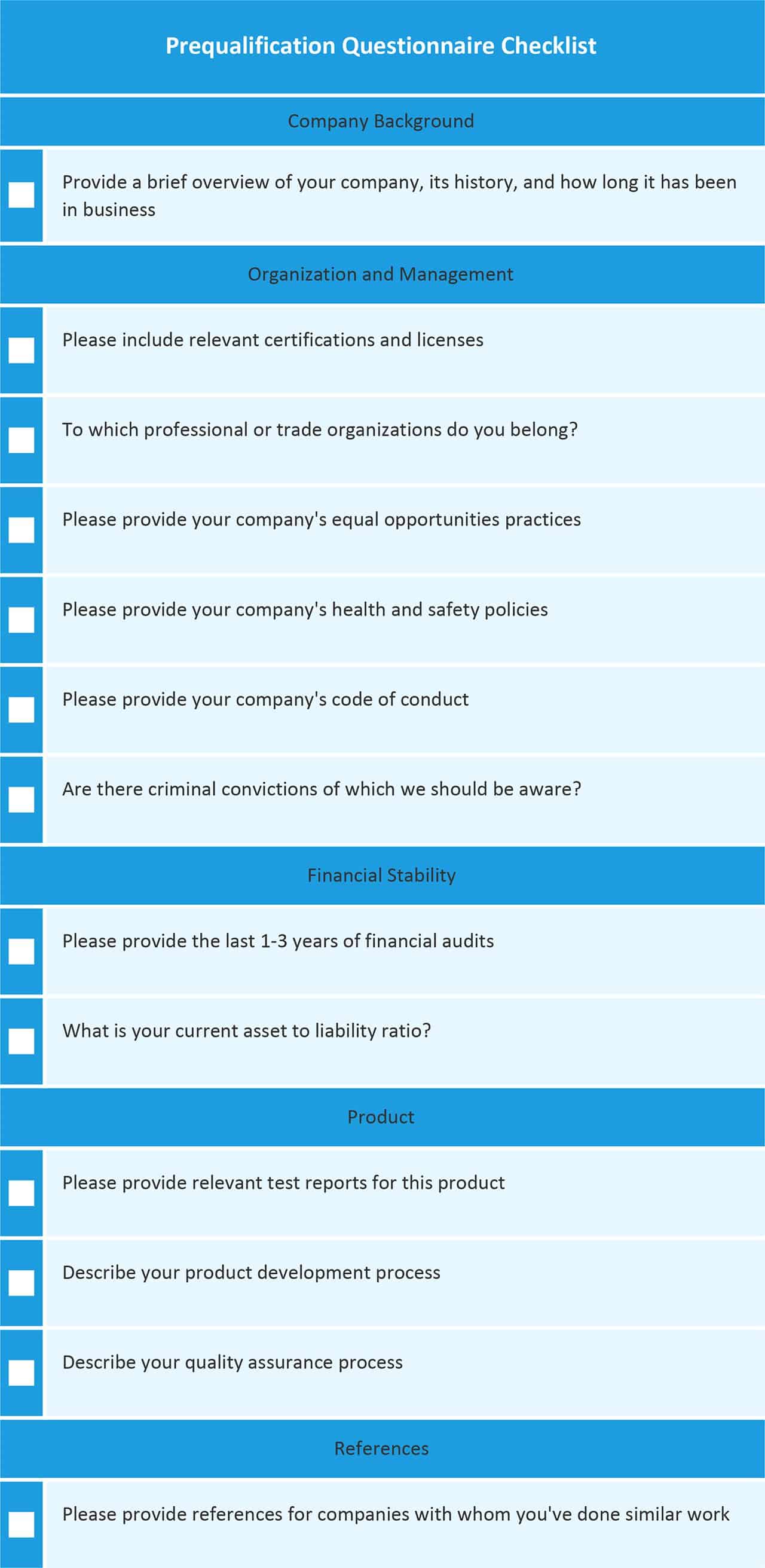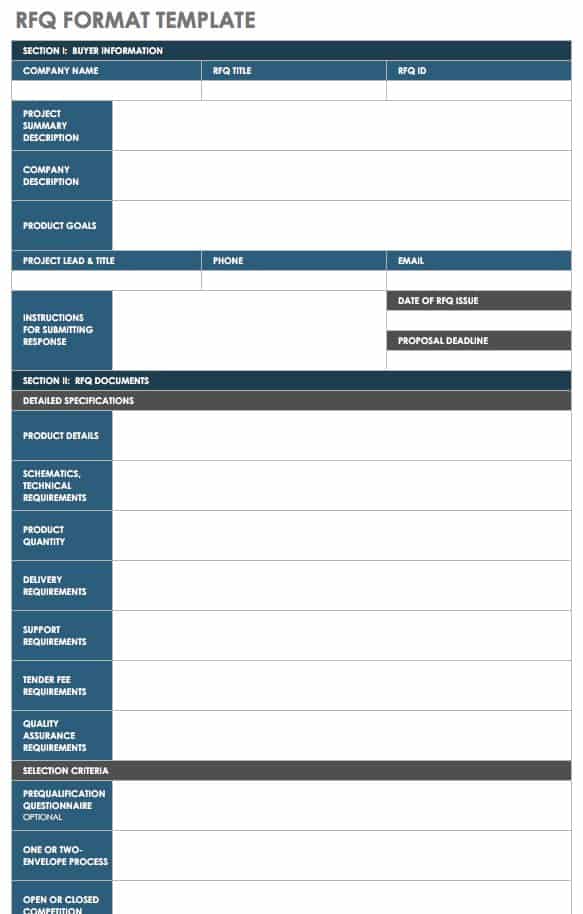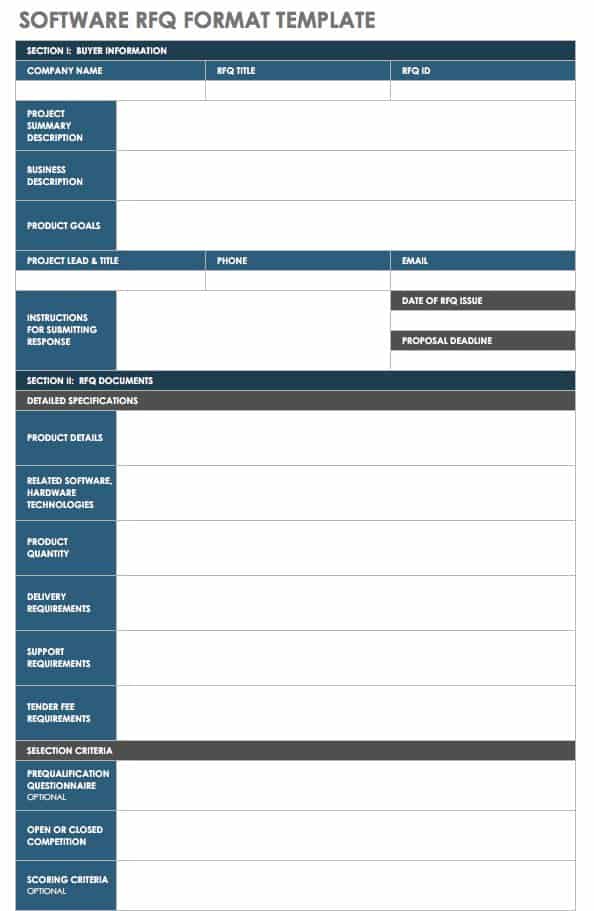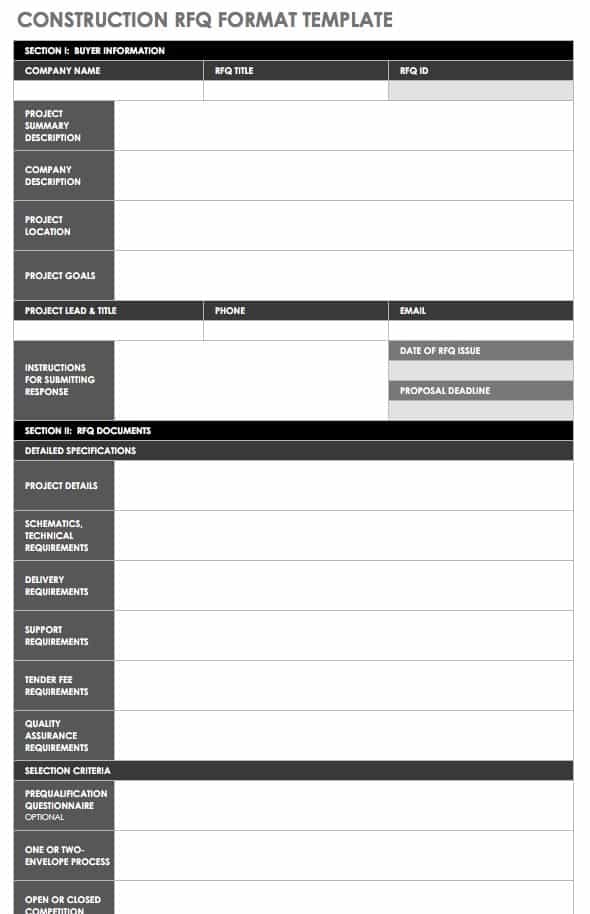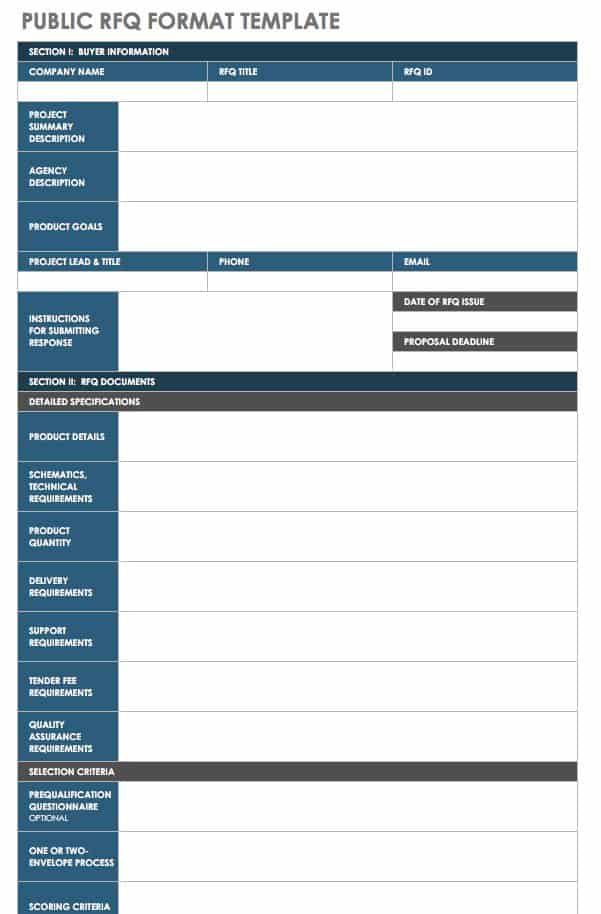What Is a Request for Quote (RFQ)?
A request for quote is a standard business process that an organization will use when they want to buy a specific product or service. Typically, a company creates and issues an RFQ, and vendors offer price quotes. The business then chooses the lowest bid and signs a contract with the preferred vendor. An RFQ is similar to an invitation to bid (ITB) or invitation for bid (IFB). A company would use any of these forms to solicit quotes from potential suppliers in the procurement process.
A request for quote allows vendors to submit bids for how much they will charge for the precise product or service you are seeking. An RFQ lets you choose the best supplier with the best value because it includes the following:
- Exact specifications for the product you want to buy, including quantities
- A request that the vendor itemize costs so you can compare bids
- A deadline for submitting responses
- A timetable for delivering the product or service
- A system for comparing bids easily
Keep in mind a quote from any potential vendor is just that: a quote. It is not a firm offer and a company can’t use an RFQ as a contract or formal agreement. Once you extend an offer to the supplier and the vendor accepts, then you create the final contract.
RFQ can also stand for request for qualifications. Use a request for quote to determine the best price for a specific product or service, and use a request for qualifications to screen potential vendors to see whether they can meet your needs and whether they adhere to your financial and professional standards.
What Does an RFQ Mean in Purchasing?
Procurement and supply managers regularly employ the RFQ process as a primary way to invite suppliers to bid on a product, such as a piece of hardware, or on a service, like a maintenance contract. As a rule, people use the RFQ process when looking for something specific or quantifiable. The RFQ is also useful because it requires vendors to itemize the costs for every stage of a product or project.
As a purchasing manager, the RFQ can be your best friend when trying to get the best price for a standardized product. Vendors usually know they are competing to provide a specific product, and will offer competitive bids that save you money. The best bids also offer competitive payment terms that can give you flexibility. When you provide concrete details about what you want to buy, you get specific price quotes that are easy to compare.
RFQs help you keep costs down by managing the bidding process. Here are several types of RFQs and how they work:
- Open Bid: The RFQ is open to all potential vendors. The bids may be opened during the process so price quotes may be revealed to other suppliers bidding on the project. While this can help drive down pricing, it also can lead to price fixing or collusion among vendors.
- Sealed Bid: The buyer opens all the bids at the same time, after the submission deadline has passed. Vendors don’t know the quotes submitted by other suppliers until the company opens the bids. Sealed bids can help fight fraud during the bidding process and provide an added layer of transparency. This option is especially beneficial if you are managing a public or government project.
- Invited: Specific vendors, usually those you’ve already worked with, are asked to bid on the product. You can use this process with either open or sealed bids.
- Reverse Auction: In a typical auction, the seller is hoping to get the highest price for a product. RFQs are a form of reverse auction. If you do not get the price you want through the first round of an RFQ, you can ask selected vendors to offer the lowest price for the product you want to buy.
What Is the Difference Between an RFQ and an RFP?
An RFQ is a critical component of your business. Yet, during the procurement process, many companies confuse RFQ with RFP (request for proposal) or RFI (request for information). In many organizations, you may see the entire process use the abbreviation RFx (x stands for any of the stages in procurement). Here’s the main difference:
- Use an RFI if you are gathering facts or looking for initial ideas about a product or service). You’re looking for information.
- Use an RFP if you have a roadmap for your business solution, but want someone to help you finalize the plans and be part of the creative process. You’re looking for proposals.
- Use an RFQ if you know exactly what you want to buy and are looking for the best price. You’re looking for price quotes.
This graphic portrays the RFx process and how to move from RFI, to RFP and RFQ.
It’s easy to understand why there is confusion between RFP and RFQ: Both use the bidding process to get the best solution at the best price, and sometimes RFQs are the initial step in an RFP. As such, companies may include RFQs as part of an RFP or follow the RFP process. The difference between the two formats is evident in the outcome: An RFP asks vendors to help with the solution to your business problem (the qualitative information you need to succeed), while an RFQ asks vendors to say how much the solution will cost (the quantitative information you can measure).
We should note that RFP as a term may be losing favor. More and more companies are turning to online solutions for procurement, which will standardize the vocabulary and the process. The request for proposal could be giving way to the request for offer (RFO), another term similar to request for quote. However, the two request documents are not the same. Here is the difference between the RFO and RFQ:
- Use an RFQ when you know what you want to buy and need to get the best price.
- Use an RFO when you are looking for solutions, as well as a product, and price is one of several factors that will affect your decision.
Want to know more about RFPs? This article walks you through the request for proposal process and explains the other types of forms you might need in project management.
Should You Use an RFQ?
Since there are so many abbreviations used during the procurement process, how do you know when to use a request for quote? Use the RFQ process if the following are true for you:
- You have created a list of qualified vendors or suppliers you know can deliver the product you need.
- You know what you want to buy and are not looking for creative solutions to a problem.
- You plan on choosing a vendor based on the best price.
- You plan to buy a product typically ordered in bulk, such as equipment parts.
- You plan to buy a product that doesn’t need any customization, which would drive up costs.
- You don’t need a service plan or support contract.
Pros and Cons of an RFQ
An RFQ focuses on the result — getting the product you want for the lowest price. But there are still choices to make in the process.
Open Bidding or Invitation Only: You probably know the vendors you want to work with when buying a product. Odds are, you have worked with them in the past and they have done a solid job with fulfillment. Perhaps you want to work with a new vendor who has a good reputation in your industry. Sending an RFQ to a small number of pre-qualified vendors expedites the selection process since you won’t need much time to review the bids or verify the vendors. On the down side, you limit the competition and may not get the best price possible.
Your Relationship With Vendors: An RFQ puts your business solidly in charge of the process. You decide what to buy, how much, and when. You also limit other purchasing options by being so specific. An RFQ works for purchasing, but it can create a perception among vendors that your organization is closed-minded and doesn’t seek creative solutions to problems.
Remember, many companies mistakenly call their request for quote a request for proposal. Be sure you know what you are looking for before you spend the time and resources soliciting bids from vendors.
Your Guide to the RFQ Process
The RFQ process is fairly straightforward. You know what you want to buy and require a simple way to tell potential vendors what you want, what you expect from their bids, and the timeline for evaluating the responses and choosing a supplier.
You can use software to automate some of this process. SaaS (software as a service) companies or e-sourcing systems host online platforms that include questions for vendors, secure online hosting where vendors can submit responses and upload overall company profiles, submission tracking and scoring, and supplier notifications.
Whether you want to invest in software or will be managing the process internally, RFQs follow the same process.
Here's a graphic that depicts the process.
Step One: Preparation
Invest the time in this phase of the project to save time later. Good preparation includes deciding exactly what you want in the product and the process. Setting up clear requirements from the beginning allows you to quickly review bids and award a contract. Work with project managers and other internal stakeholders to make sure you’ve identified all the necessary requirements and have established the best RFQ process. Your RFQ should include the following:
- Specific parts or products, with detailed descriptions
- Delivery requirements
- Product quantity
- Payment terms
- Selection criteria
- RFQ timeline and review process
- Terms and conditions
- Submission requirements
At this point, decide who should respond to the RFQ. Will it be an open bid or will you invite pre-selected vendors? Will you seal the bids until the deadline or open and reveal bids during the process? Depending on the specific product and budget, you may want to limit this process to a few vendors. Or, if you are trying to discover the best price for the product, you may open the RFQ to a wider audience.
Identify how much risk you are willing to assume with the chosen vendor. As part of the preparation phase, acknowledge any monetary risk, or even changes to quality or delivery. Internal stakeholders can help with the risk assessment.
Include RFQ documents such as a draft contract with terms and conditions, and a pricing template. To help with process, create a form with fields for price per unit, quantity, and total price that vendors complete as part of their RFQ response. This information will let you easily compare bids. Here’s an example of a pricing template for vendors to complete and include with their response.
Download Pricing Template
Step Two: Management
Send the RFQ to the vendors (either ones you have pre-selected or found through public channels) and be sure to allow enough time for them to respond with a thoughtful quote. During this phase, be prepared to answer questions about the RFQ and share the answers with all the vendors. You may find it helpful to track the queries as you answer them to help with subsequent projects or pricing.
It's essential during this time to treat everyone equally — this will ensure that you conduct a transparent and fair bidding process. Don't provide more information to some vendors than others and stick to any confidentiality requirements spelled out in the RFQ as you receive the bids.
Keep track of the responses as they come in and acknowledge their receipt. Be sure to notify the selection committee of your progress, so those members will know how much time to set aside to review the bids. Depending on your process (and the size of the contract) you may choose to open all the bids once the deadline has passed, or to open the bids as they arrive. Put safeguards in place to ensure that, if you open the bids as they come in, you are protecting the confidentiality of each vendor’s response.
Step Three: Awarding the Contract
Once the deadline has passed for receiving bids, the reviewer or review committee can now compare the submissions based on the selection criteria. If you've used a template or form to collect price quotes, it should be easy to compare the bids. The winner will be the lowest price at the best terms. Based on that RFQ response, you can create a contract or purchase order to finalize the deal.
Document the winner, the process, the number of bids, and criteria in an internal memo. This information will be a valuable for the internal auditor, and will provide guidance for future projects.
Step Four: Closing
The contract should be fairly easy to finalize and sign since many of the contract details were part of the RFQ process, including terms and conditions, payment, and other deliverables. There may be some negotiation still left to do such as packaging, changes in pricing levels, or delivery schedule.
Once the contract is signed, notify the other vendors that a winner has been chosen and thank them for their participation. You may want these vendors to be part of your product cycle in the future. Treat them ethically at this stage and they will be willing to invest the time in bidding on future projects.
Writing an RFQ
All RFQs cover key information about the product or service you want to buy. While RFQs may vary a bit by industry, they all feature the following sections:
- Introduction and Executive Summary: Give vendors an overview of your company and the requirements for the product. Since this is also a summary of the project, you’ll probably write this section after completing the rest of the RFQ.
- Business Overview and Background: Describe your business and how the product in this RFQ will help you meet your goals. Consider including a brief summary of the market and anything else the vendor needs to know to bid on the project.
- Pricing Template: A pricing template lets you compare bids easily. Specific categories in your template can be cost elements and cost drivers. While templates will vary from product to product and RFQ to RFQ, the goal is to have all the information for a specific product in the same format so you can compare the bids quickly, easily, and accurately.
- Prequalification Questionnaire: Vendors often are vetted during the RFI process. If you waited until the RFQ to make sure you are working with qualified vendors, include a questionnaire in the RFQ documents. Here are some sample questions to help you learn about a vendor's organization, business structure, ability to do the work, and references.
Download Prequalification Checklist
- Detailed Specifications: This section is the meat of the RFQ. Be specific about the product you want so you can get accurate and fair price quotes. You can include the following details:
- Product schematics or hardware requirements
- Part descriptions or item number
- Quantity
- Technical requirements
- Quality requirements
- Deliverables
- Tender Fee: In public sector RFQs, an official fee (or tender fee) typically is required to ensure that the process is open and transparent. You may also want to require an earnest money deposit (EMD) as a way for vendors to demonstrate good faith in the bid. The money typically is held in escrow during the RFQ process. If the vendor earns the contract, the fee is included in the payment schedule. The remaining money in escrow is returned to the other bidders.
- Assumptions and Constraints: There may be other parts of this project that are not specifically included in the pricing for the product featured in your RFQ. In this section, list any other factors, such as licenses that need to be earned or awarded, travel expenses for the vendor, or other anticipated costs that the vendor might have to assume.
- Contract Terms and Conditions: List the general terms and conditions (GTC) for the contract, and explain which terms are negotiable. The GTC typically includes payment terms, contract length, warranties, performance penalties or incentives, and renewal options. This gives vendors additional information to weigh when considering whether to respond to your RFQ. It also saves time during contract negotiations, since you've already explained what is open for discussion and what is not negotiable.
- Selection Criteria: As part of the RFQ process, you have established the criteria for awarding a contract. The decision to include this information in the RFQ is strategic. Some companies include this information in the RFQ, as they believe it will help vendors understand the business culture and structure; others keep this confidential.
- Submission Details: Be sure to include the contact person for questions, the deadline for submitting a bid, the format for the bid, and any other relevant details. You may also choose to have vendors submit their entire RFQ response in a form to expedite the bid-reviewing process. These standardized templates create apples-to-apples comparisons for you and the selection team.
Since the parts of an RFQ are similar from project to project, you can use a simple template or form for each new request and simply complete the sections needed. Here is a template with the essential components of any RFQ that you can use for a variety of industries, including the private sector or a small business.
Download Free RFQ Template
Best Practices for Writing an RFQ
Don’t assume that sharing an RFQ with pre-selected and pre-qualified vendors will yield high-quality responses and the best prices. You will receive better bids if you have a clearly written, well-organized RFQ. Here are some best practices for writing an RFQ:
- Use a Template: An RFQ is packed with information. Use a template to ensure consistent formatting that potential bidders can read and respond to easily.
- Be Specific About Your Product: Tell vendors your exact requirements and ask them to be precise in their response.
- Define Your Expectations: Describe what you want in the RFQ response (this is where templates come in handy). Even more, your business hinges on whether the vendor can deliver. Describe what you want, when you want it, and what happens if the vendor exceeds your expectations about deliverables — or fails to deliver.
- Ask Relevant Questions: Time is a precious resource for companies. Don’t waste vendors’ time by asking questions in the RFQ that don’t specifically relate to your product.
- Set Appropriate Deadlines: Give vendors the an adequate timeframe to prepare a thoughtful response. For smaller RFQs, two weeks is a good start. Add more time depending on the size of the project and the amount of information in the RFQ.
- Review and Revise the RFQ: Writing is really rewriting. Once you draft the RFQ, ask key stakeholders and trusted partners to review it and answer these two questions: Have you correctly identified your needs, and have you left out any critical details?
How to Respond to an RFQ
While the primary goal of an RFQ response is to provide pricing and payment terms, there are other factors that make a response shine. Make the following clear:
- You deliver on time.
- You can be flexible if the requirements change.
- You have experience or history of meeting other buyers’ needs.
- You provide added value to the buyer.
Be mindful that this RFQ could lead to other opportunities. Even if you don’t win this particular RFQ, demonstrate that you could be a strong vendor in the future. Craft your response to demonstrate that you understand the buyer’s strategic goals and that you can build a relationship for future projects. When writing your response, do the following:
- Read the RFQ carefully and follow directions, address all the questions, and provide thoughtful responses.
- Do some homework and understand the buyer’s overall business.
- Identify whether you might need to work with subcontractors to meet all the buyer’s requirements.
- Take the time to fully prepare your response, but don’t miss their deadline.
- Be organized, clear, and professional in your responses to their questions.
If the buyer has provided a form that the company wants you to complete, follow the directions. For example, IBM provides an explanation for completing its RFQs.
If the buyer doesn’t have an RFQ form or template to complete, organize your proposal this way:
- Cover Page: Keep it simple.
- Table of Contents: This will guide the buyer through your response.
- Introduction: Offer a general summary that states your business case.
- Documents: This section should include a price description and any other project requirements.
- Company Overview: Include relevant experience, capacity, certifications, and licenses.
- Approach: This is where you will explain your approach to fulfilling the RFQ, including your company’s organization, key players, and timetable for deliverables.
- Description of Your Project Management Process: Include communication strategy, any assumptions about the project, and how you will ensure delivery.
Specialized Uses for an RFQ
A wide range of organizations use RFQs to get the best price for a product and to identify future qualified vendors. However, there are some particular nuances found across different industries.
Hardware of Software RFQ Form
Companies that issue RFQs for software or hardware are looking for specific responses to predetermined needs. Use an RFQ if you are adding to an existing system rather than trying to build something new. Make sure you list exact specifications, otherwise you’ll get a range of creative responses that don’t address the system needs. See our Software RFQ Template.
Download Software RFQ Template
Construction and Industry RFQ Template
RFQs are common for procurement in construction, especially in the supply chain department. They are designed to evaluate the capacity of potential vendors and can be used as part of the pre-screening process. RFQs typically follow an RFI, and may be included as part of an RFP or the last phase of an RFP. Regardless of where the RFQ falls in the process, create one primarily if the terms are financial to obtain pricing specifics and details about meeting those requirements. RFQs are uncommon in project work. See our form for completing a construction RFQ.
Download Construction and Industry RFQ
RFQ Template for the Public Sector
In business and all private-sector RFQs, the option is available to work with pre-qualified vendors and keep sensitive business information private. By its very nature, however, public-sector bids must be open to the public. That means every step of the process (from writing the RFQ to reviewing bids and signing the contract) is visible to vendors and others interested in the work.
There can be exceptions depending on the size of the project. Government agencies are guided by Federal Acquisition Regulation (FAR), which helps ensure you comply with transparency and procurement mandates. These regulations define what must be included in the procurement process and cover everything from the RFI to the RFQ and contract negotiations.
One technique government agencies use to comply with these regulations is to conduct two-envelope bidding. In this process, the price bids and the technical bids are two sealed offerings, submitted in one response. A technical panel reviews the technical responses, without access to the pricing information, to choose the best vendor. Then the buyer opens the price bids and determines the most advantageous offer.
If you are merely buying a quantity of a product (laptops, for example), you typically can use single-step procurement since you just want to determine the best price for a predetermined product. Use the two-step or two-envelope process when qualifying vendors or comparing how they will meet your technical requirements without the pricetag influencing your decision. See our form for completing a public sector RFQ.
Download Public Sector RFQ
Where to Find RFQs
Vendor websites let you submit your RFQ and then collect responses. These include Alibaba, Global Sources, and Spiceworks. Complete the online form with the details for your product. You will receive bids from several vendors so you can weigh options and make the best choice for your business. As a vendor, you can find hundreds of RFQs to bid on through these sites.
Most government agencies list their RFQ on their own site. These also are gathered on several sites, including FindRFP , which lists federal, state, and local government RFQs and bidding opportunities.
Improve Your Request for Quote Process with Smartsheet
Empower your people to go above and beyond with a flexible platform designed to match the needs of your team — and adapt as those needs change.
The Smartsheet platform makes it easy to plan, capture, manage, and report on work from anywhere, helping your team be more effective and get more done. Report on key metrics and get real-time visibility into work as it happens with roll-up reports, dashboards, and automated workflows built to keep your team connected and informed.
When teams have clarity into the work getting done, there’s no telling how much more they can accomplish in the same amount of time. Try Smartsheet for free, today.
